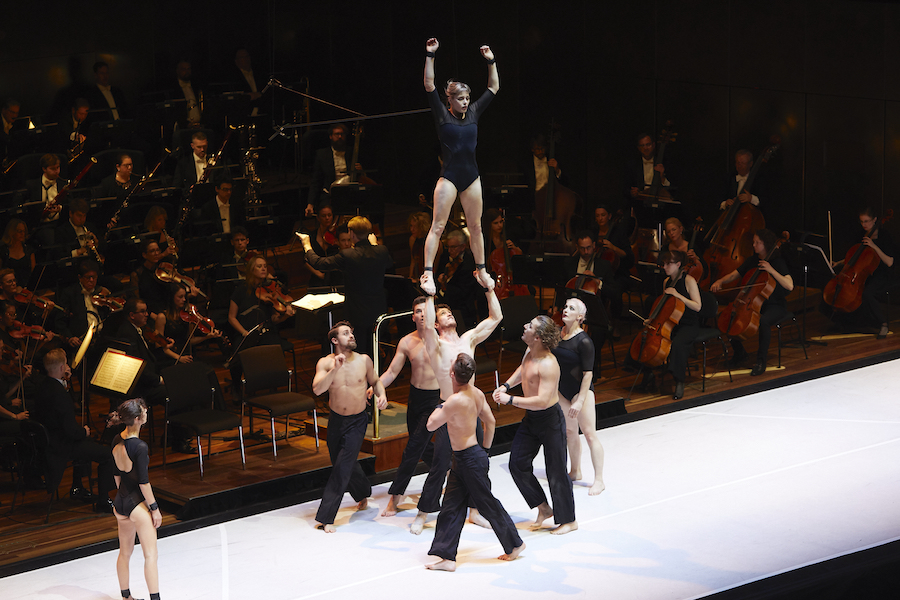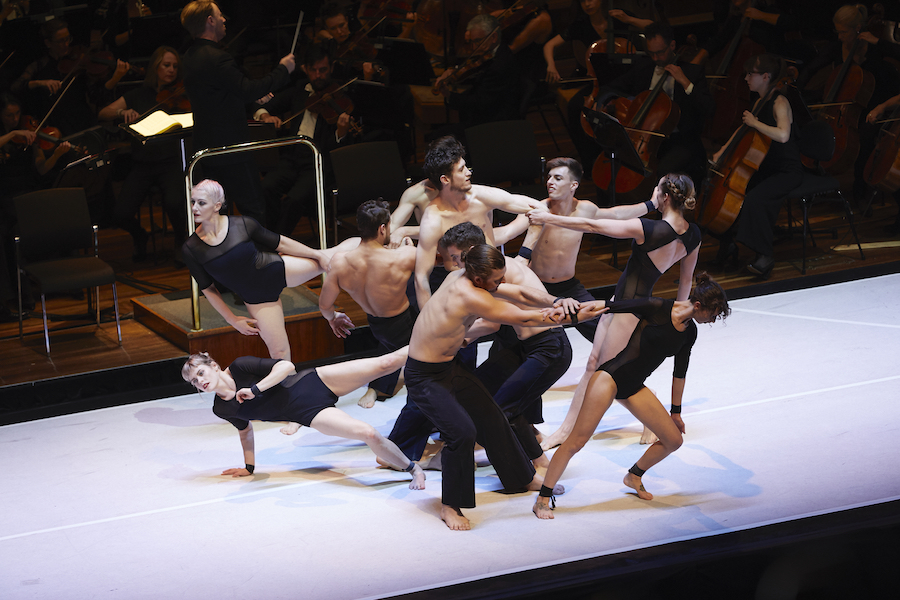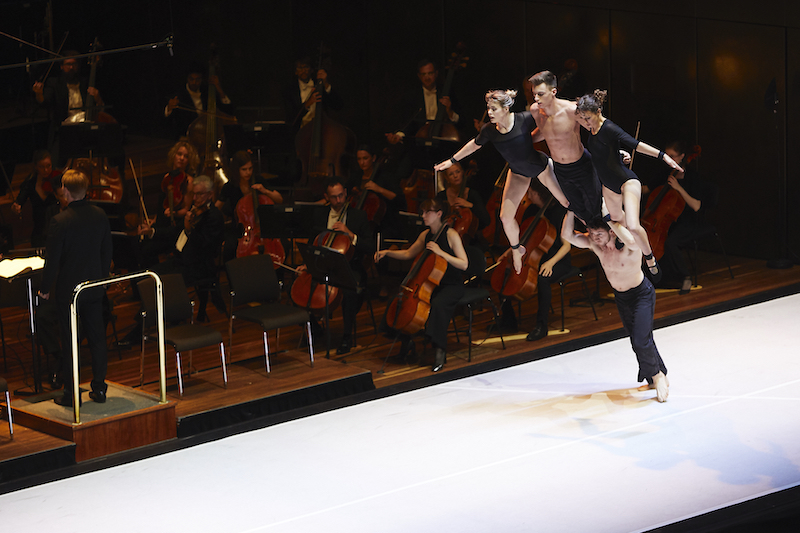Some critics tend to think anniversary programming is unimaginative. Poor old Ludwig van Beethoven, then, who turns 250 this year, and whose work – though never far from our concert halls – will be the bread and butter of many orchestras and chamber ensembles across the globe. When we consider that he was the creator of some of the greatest works in the Western classical tradition, railing against Beethoven also starts to look like pointless iconoclasm. It was therefore refreshing to see the Melbourne Symphony Orchestra opening its 2020 season with one of the most well-loved of Beethoven’s works, the Ninth Symphony.
 Circa Contemporary Circus and the Melbourne Symphony Orchestra. Photo © Laura Manariti
Circa Contemporary Circus and the Melbourne Symphony Orchestra. Photo © Laura Manariti
And far from being unimaginative about it all, the MSO first invited the celebrated Yorta Yorta singer and composer Deborah Cheetham AO to pen a modern, Australian response to the Ninth. Those familiar with the text of the finale – the Ode to Joy – might be aware of its English translation. The final stanza of Friedrich Schiller’s work reads, in one rendering from the original German: ‘Do you bow down before Him, you millions? / Do you sense your Creator, O world? / Seek Him above the canopy of stars! / He must dwell beyond the stars.’
An Indigenous Australian response to this cosmological vision is apt. The landscape, the sky, and the people and animals that live there are intimately related in the Dreaming. These stories emanate from the land itself and help to explain how all the various parts of the cosmos are related to one another. The ancestral spirits of Aboriginal Creation mythologies are present in the landscape and the animals that live there and are reflected in the night sky.
Dutala, star filled sky, is Cheetham’s companion piece to Beethoven’s Ninth, and the MSO’S 2020 season formally and bravely opened with its world premiere. Cheetham translates the final stanza of Schiller’s text to Yorta Yorta: “Biami gabra ngata nhurrag wuta wungi? / Biami yamutj Dutala bukut / Biami banga dhona Dutala bukut.” Biami, the creator, also featured in Cheetham’s opera Pecan Summer, which deals with the recent history of the Yorta Yorta people but offers glimpses, too, of the creation of the river Dhungala – the Murray River. The Dreaming features prominently in Dutala.
 Photo © Laura Manariti
Photo © Laura Manariti
Writing for Limelight, Cheetham says that “the framework for Dutala is drawn from the same orchestral and choral forces that changed the way we would think of the symphonic form forever”, that is, the Ninth. The work is rich and evocative, drawing explicitly on Beethoven in some parts, but more broadly mining from a distinctly Australian contemporary classical vernacular. Cheetham lights up the Australian night sky as Peter Sculthorpe had so vividly painted the Australian landscape many years before. Dutala is a distinctly Indigenous and Yorta Yorta response to Beethoven’s canopy of stars: “There are many forces in nature which have influenced or inspired my compositional style – Biyala (the River Red Gum), woka (the earth), wala (water) and birds are ever present. Inevitably though, my gaze would turn towards the sky. To the stars and the space between the stars. Dutala, star filled sky. For a long time, I considered the addition of a subtitle for this work – the spaces between. For this is where Indigenous cultures focus their attention when interpreting the sky. The spaces between the stars.” We hear all of this in Dutala.
“Give me my language and I will show you my identity,” says Cheetham. Some say Beethoven could not, in the end, express himself fully without language. An early music historian, Adolph Bernhard Marx, wrote that by the time the Ninth reaches its finale “unreal instrumental voices no longer satisfy [Beethoven], and he is drawn irresistibly back to the human voice.”
The choral finale, always in safe hands with the MSO Chorus, might not have been. The finale of Beethoven’s A Minor String Quartet was once destined for the Ninth, and in a solemn moment, he said that the choral finale was a mistake, and that he wished he had written an instrumental finale instead. Critics said it was the incomprehensible work of a deaf, mad and aging composer. Verdi wrote of the work that the Ninth was “marvellous in the first three movements, very badly set in the last. No one will ever approach the sublimity of the first movement, but it will be an easy task to write as badly for voices as in the last movement.”
As the musicologist Sir Donald Tovey once wrote, however, any other finale “would certainly never have served the purpose.” Tovey was, he said, “a fervent upholder of the choral finale, which is a perfect set of variations presenting to me no more difficulties of musical form than any Bach fugue; and wisdom after the actual event, together with utter lack of prophetic insight into what did not take place, makes it impossible for me to conceive of any other finale.” Which is to say, the choral finale makes perfect musical sense, despite its early detractors, and who among us could imagine the Ninth without it?
 Photo © Laura Manariti
Photo © Laura Manariti
Wagner thought that Beethoven, bursting with drama and passion, felt an imperative to break into words. As Marx put it, “when the string basses painfully attempt their ungainly imitation of human speech; and when they begin to hum timidly the simple human tune, and hand it over to the rest of the orchestra, we see that, after all, the needs of humanity reach beyond the enchanted world of instruments, so that, in the end, Beethoven only finds satisfaction in the chorus of humanity itself.”
When bass Warwick Fyfe heralded the famous Ode To Joy – his announcement, in its English translation, is “Oh friends, no more of these sounds! Let us sing more cheerful songs, More full of joy!” – we could see both Wagner and Marx’s point. The British organist Sir Walter Parratt told a story by way of an allegory for the Ninth: he recalled once seeing “a man haranguing a crowed and becoming more and more passionate until it seemed as if no human frame could stand such a stress. Suddenly the man broke into dance, very rhythmic and not ungraceful, and danced his passion away in perfect silence.” Such was, as Tovey puts it, the “Bacchic frenzy of that choral finale”.
It was appropriate, therefore, that a circus should join the orchestra on stage. The Queensland-based Circa Contemporary Circus is internationally acclaimed for good reasons. Under long-time director, Yaron Lifschitz, the contemporary troupe blurs dance, theatre, and circus in performances of extreme physicality. The collaboration with the MSO is, it is believed, the world’s first acrobatic staging of the Ninth.
Circa’s interpretation of the Ninth was visceral – “very rhythmic and not ungraceful” – shifting between shadow and light, contorting into living sculptures both grotesque and elegant, and all too human. The traditional acrobatic circus elements were present, too, albeit far abstracted from the entertainments of childhood. A lone hoop was manipulated in a flowing solo, and later duet, performance. As the piece neared its climax, silks were deployed for aerial contortions – climbing, wrapping, and dropping – that became increasingly frenzied. A trapeze was even hung high above the stage of Hamer Hall. Melbourne has never seen a staging of the Ninth like this.
The orchestra, directed through the night under the always sure hand of Benjamin Northey, received a lengthy standing ovation at the conclusion of the performance. It is hard to say whether this was in recognition of the music or the circus, for both were masterfully intertwined, and each element was made all the more exciting and, indeed, imaginative, by the other.











Comments
Log in to join the conversation.